This article relies heavily on the advice of unnamed others. Sincere thanks to everybody who has helped. Information and corrections welcome. Contact the author HERE
"turning the Arctic into Russia's own back yard"

 : This analysis follows on from the Belgorod submarine analysis. A recent article in the Russian Izvestia newspaper (http://izvestia.ru/news/623040) supports suspicions that Russia is planning a new network of naval installations in the Arctic. Together with other indications, this builds a picture of a program which one observer characterized as "turning the Arctic into Russia's own back yard."
: This analysis follows on from the Belgorod submarine analysis. A recent article in the Russian Izvestia newspaper (http://izvestia.ru/news/623040) supports suspicions that Russia is planning a new network of naval installations in the Arctic. Together with other indications, this builds a picture of a program which one observer characterized as "turning the Arctic into Russia's own back yard."
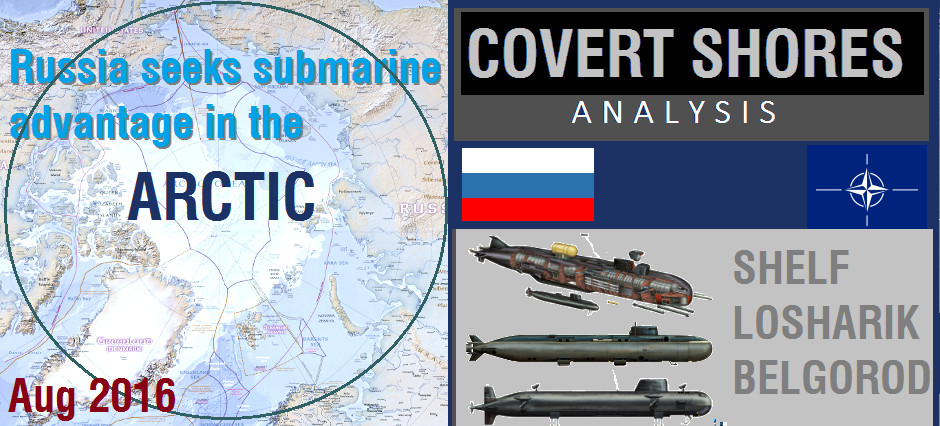
The network will consist of a multiple sonar arrays analogous to the famous US Navy SOSUS system (actually nothing like the vintage SOSUS in technology terms but a convenient analogy). The logical aim is to provide Russia with real-time tracking of the latest NATO submarines operating in northern waters. This addresses the NATO submarine advantage head-on and would allow persecution of prowling US-UK nuclear powered attack submarines, and improve survivability for Russia's own nuclear armed ballistic missile submarines.
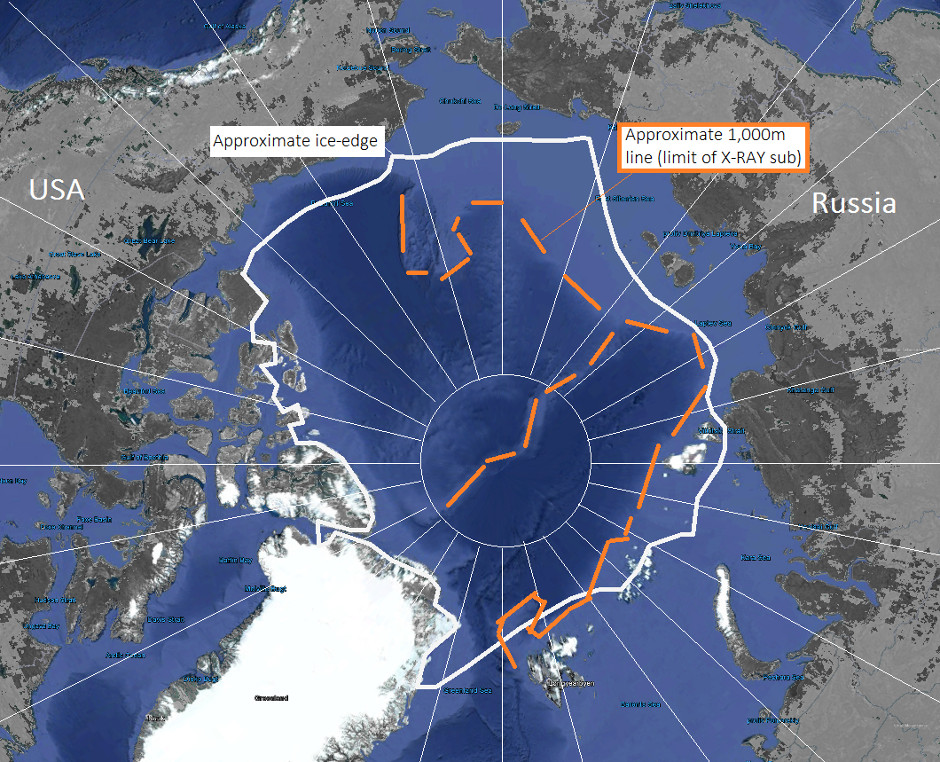
The Arctic Ocean has two basins in the middle, divided in half by a massive mountainous ridge. The basins are surrounded by shelfs where the sea floor drops from about 1,000m down to around 4,000m. Given that the midget submarines carried by Belgorod can dive to about 1,000m, these shelves represent the edge of where the sensor arrays might be placed. Additionally there are areas with mountain peeks at less than 1,000m where arrays could be placed.
Russia is already installing the new MGK-608M SEVER sonar system in the nearby Barents Sea. This will replace the previous MGK-608 system which has been in use for over twenty years. The SEVER sonar system consists of a string of seabed short line arrays connected by undersea cables to ground stations which can be up to 200km (110nm) away. The new system may be an extension of SEVER and/or leverage existing components such as the sea-floor sonar modules.
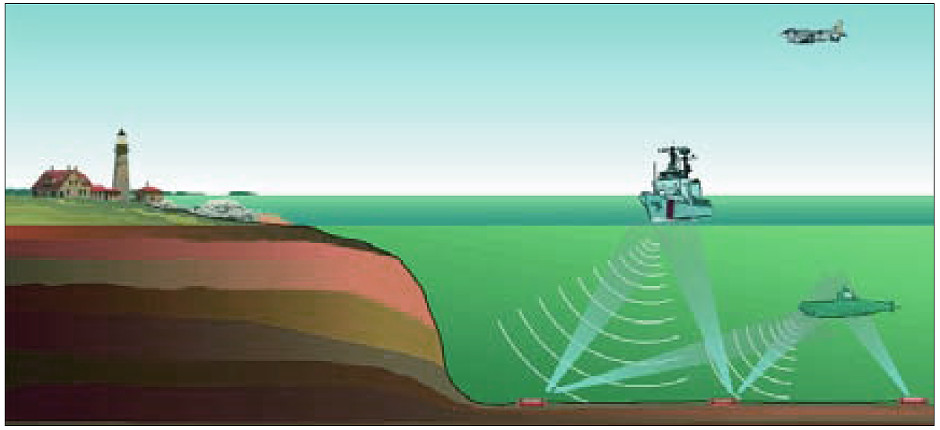

* MGK-608E sonar system.* (Rosoboronexport)
The Izvestia article is important because it confirms the project, but it is light on detail. It identifies three components:
- underwater sonar (by implication on the sea floor)
- floating 'sonar-buoys'
- satellites
The strategic and geopolitical implications of the system are undoubtedly significant and may amount to a new arms race in the Arctic.
The Izvestia article's emphasis of the satellite component is misleading and possibly due to the source of the information (someone close to Almaz-Antei since it is the only company mentioned?) reinforced by the common perception that Russia has used satellites to detect NATO submarines from space. Clearly satellites are of limited value for spotting a submarine operating beneath the Arctic ice. Instead they will most likely be the communications link allowing multiple isolated sensor arrays to form a single network. The underwater sensors are likely limited to passive sonar since wake-detection devices have very limited range and active sonar is a virtual non-starter under the ice due to the large number of spurious reflections. The strategic and geopolitical implications of the system are however undoubtedly significant and may amount to a new arms race in the Arctic.
Get The essential guide to World Submarines
This Covert Shores Recognition Guide Covers over 80 classes of submarines including all types currently in service with World Navies.Check it out on Amazon
...GUGI (main directorate of underwater research - a euphemism for covert underwater activity including espionage)
The other information which joins with the Izvestia article is more intriguing. Some analysts have been closely observing the continuing regeneration of Russia's unusual and under-reported 'Special Mission' submarines. These are operated by the Russian Navy on behalf of the secretive GUGI (main directorate of underwater research - a euphemism for covert underwater activity including espionage). Recently one of their submarines, the unique Losharik deep diving boat, has been mentioned in Western media and attracted some interest. But there are a whole fleet of 'spy submarines' in addition to the fascinating Losharik. Most significantly, Russia is converting two large submarines to act as motherships (MOSUBs) for deep diving midget subs like the Losharik and the two smaller PALTUS class.
The first mother sub is an unfinished OSCAR-II class cruise missile submarine Project 09852 Belgorod. This is a gigantic boat from the Class that will be the largest submarines in the world when/if the last of the TYPHOON Class is retired.
Original artwork - CLICK for HIGH-RESOLUTION image:
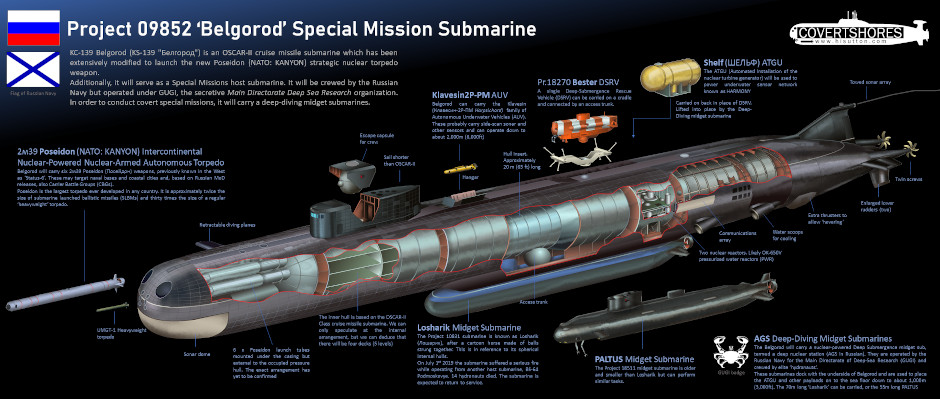
The second is the former DELTA-IV ballistic missile submarine Project 09787 Moscow. This has had the missile section swapped with new compartments. Despite this freeing-up huge internal volume, the sub has been lengthened and is now known as DELTA-IV STRETCH. Moscow is also massive, being closer in size to the US Navy's Ohio Class boats. These conversions are undoubtedly extremely expensive (construction of an OSCAR class submarine has been described as half the cost of an aircraft carrier) and demonstrate Russia's commitment to these secretive capabilities in the face of financial stress and competing priorities.
In total the GUGI 'special mission' fleet will, by year end, be:
Large mother submarines
1 x DELTA-III STRETCH (Project.09786 BS-136 "Orenburg")
1 x DELTA-IV STRETCH (Project 09787 BS-64 "Moscow" – to be completed 2016)
1 x OSCAR-II Conversion (Project 09852 KC-139 "Belgorod" – to be completed 2016)
Deep diving midget submarines for operation from mother submarines
1 x LOSHARIK (Project 10831 AC-31 Losharik)
2 x PALTUS (Project 18511 "Halibut" - AC-21, AC-35)
1 x X-RAY (Project 18510 "Nelma" AC-23) -Possibly retired
Deep diving midget submarines for independent operation
3 x UNIFORM (Project 1910 “Sperm Whale” АС-13, АС-15, АС-33) –One or more possibly retired
Main article on  Project 09852 Belgorod Special Mission submarine (spy sub)
Project 09852 Belgorod Special Mission submarine (spy sub)
Main article on  LOSHARIK deep diving spy sub
LOSHARIK deep diving spy sub
Main article on  Project 1910 UNIFORM Class deep diving spy sub
Project 1910 UNIFORM Class deep diving spy sub
Not all boats will be at the same state of operational readiness and the latest mother subs will take some time to reach operational status. However the fleet is out of all proportion to any other country's investment in such Special Mission boats, even the USN.
One specific indication of the Arctic placement is that both new mother submarines have been illustrated in Russian sources with large pod-like payloads carried on their back. This includes the 'Status-6 leak' were the world glimpsed the KANYON nuclear weapon being shown to Vladimir Putin. In the top left of the presentation is the OSCAR-II conversion Belgorod complete with deep diving midget submarine and a conspicuous payload on its back

Undersea Nuclear power plants
Russian sources have linked the payload to a self-contained nuclear power plant known as SHELF (ШЕЛЬФ) developed by NIKIET, part of Russian nuclear energy agency ROSATOM. It is not yet clear if the SHELF refers to the power plant itself, a submarine project or the sonar system, but a hint is in the name: Russia commonly refers to the Arctic Ocean area by the geographic term Shelf because of a steep drop off into a Basin under the ice (the sea floor all around the Arctic is a series of named plains, ridges and basins, see this map)
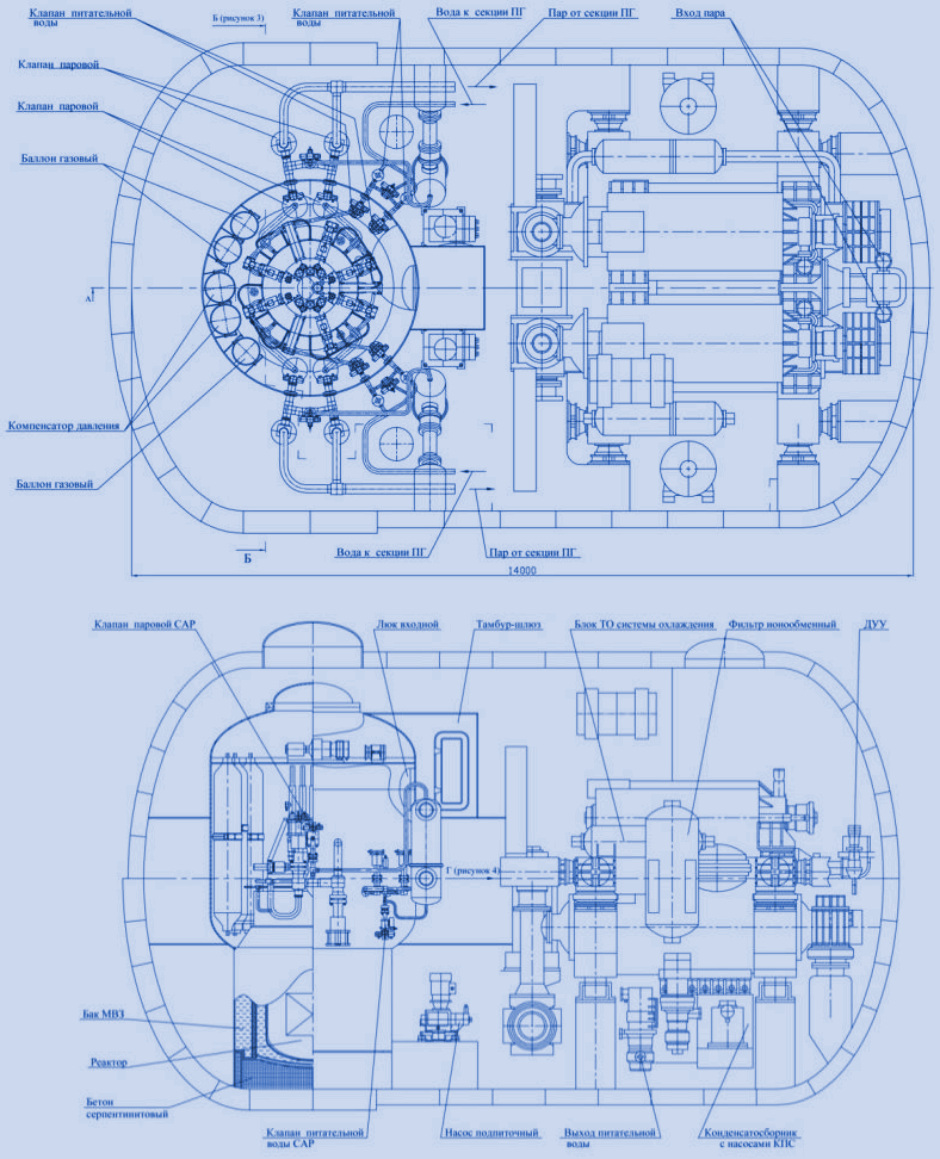
The ATGU is a general purpose installation intended for on-land and undersea applications, and is likely to be passed off as having civilian applications even when carried by a Navy submarine.
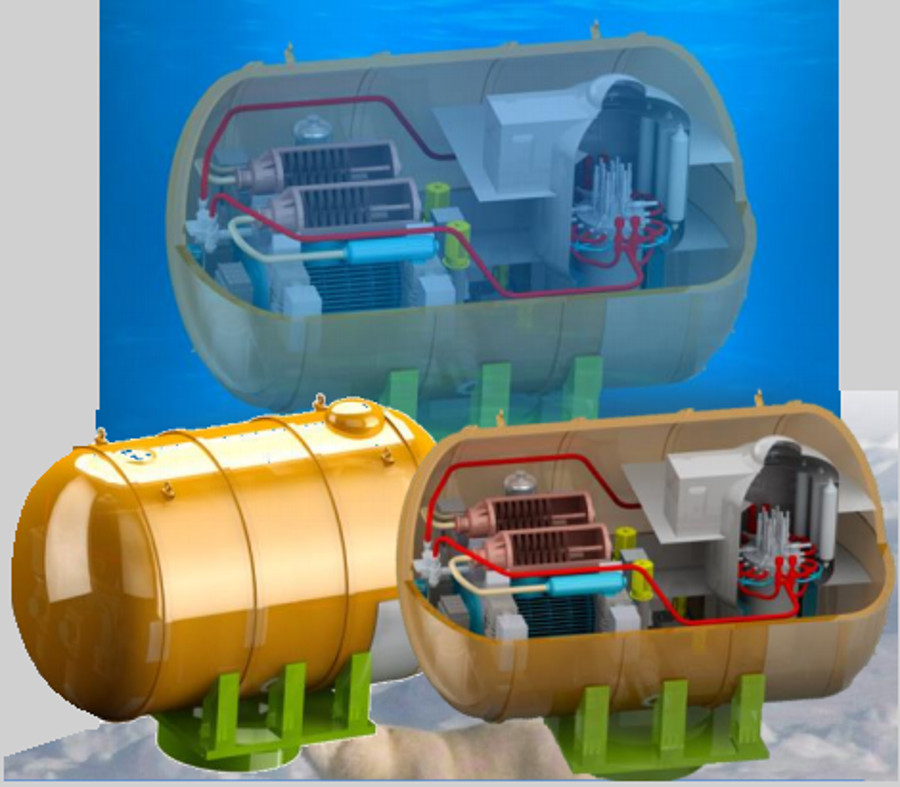
The ATGU will connect to one or more sensor arrays by a relatively short (and therefore light) cable. Any large sensor systems are likely to be carried on the Belgorod’s back in the same manner as the ATGU.
The nature of the SHELF Automated ATGU (Атомная турбогенераторная установка: Nuclear Turbine Generator) tells us a lot about the system. As the name suggests it is an unmanned nuclear power generator which operates completely autonomous, like a 'nuclear power station in a box'. Except that the box is a 8m diameter by 14m (26ft X 46ft) 335 ton pressure container which can withstand being placed on the sea floor. The arrangement is described as an Energykapsule by the manufacturer. It can also be placed on dry land and has a range of potential military and civilian uses. The power output of a single Energykapsule is quite low at 44kW with pumped circulation and about 28kW with natural circulation.
Learn EVERYTHING about Special Forces subs Covert Shores 2nd Edition. A world history of naval Special Forces, their missions and their specialist vehicles. SEALs, SBS, COMSUBIN, Sh-13, Spetsnaz, Kampfschwimmers, Commando Hubert, 4RR and many more.
Check it out on Amazon
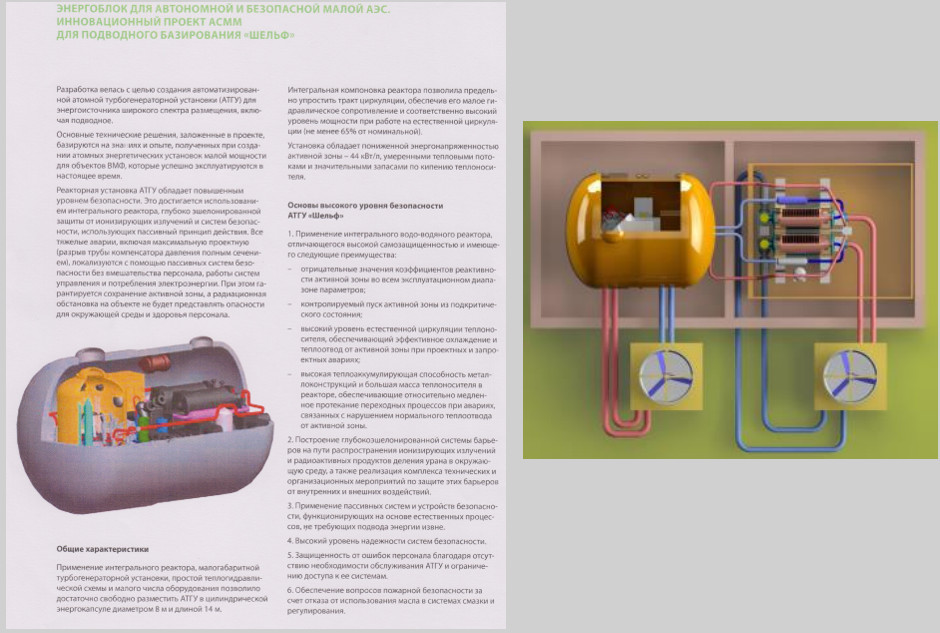
According to NIKIET the integral reactor allows for a simplified arrangement of the circulation path, reducing flow resistance and providing a relatively high power level when operating on natural circulation (at least 65% of the max). Official sources quote the power output as 6.4 megawatts, which is far more than would be required by a sonar network. Earlier NIKIET sources quoted a smaller low-density figure of 44 kW / l which would fit with the sensor network role. It has moderate heat fluxes and significant reserves of coolant boiling.
Another reactor design bureau, OKBM, is working on a much larger 'Underwater Uninhabited Nuclear Power Modules' (ПНАЭМ = PNAE) complex named ’Gidropress’ (ГИДРОПРЕСС). The scalable 10-50MW reactor uses a lead-bismuth cooled fast reactor based on technology developed for the famous Project 705K ALFA Class submarine.
It is expressly design for under-ice deployment in the Arctic with a concept illustration showing a Project 18271 (BESTER Class) midget submarine and a Remote Operated Vehicle (ROV). Design work was carried out in support of SPMBM Malachite with the main customer as the Ministry of Industry and Trade (of the Russian Federation). When taken together with the high energy output, the Gidropress PNAE reactor is likely intended for civilian applications.
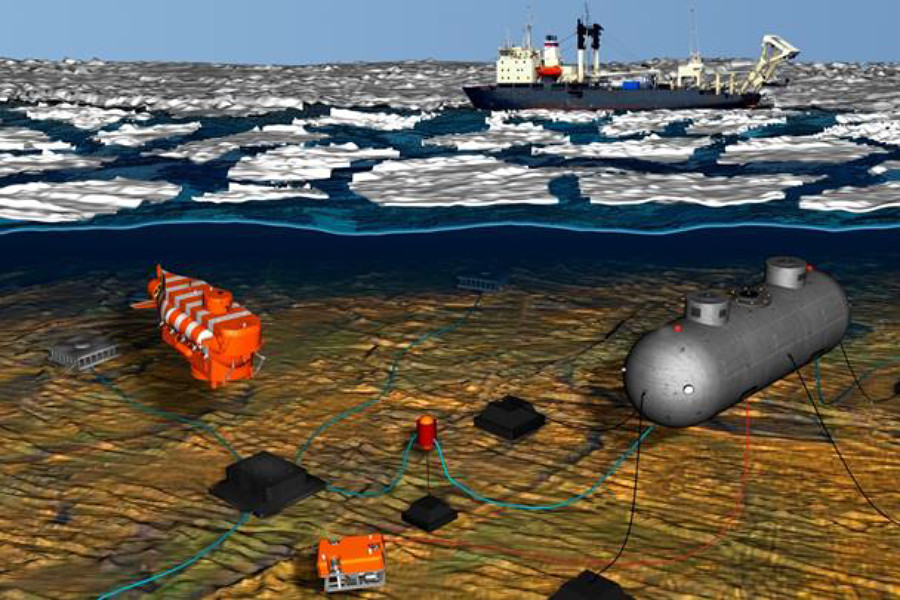
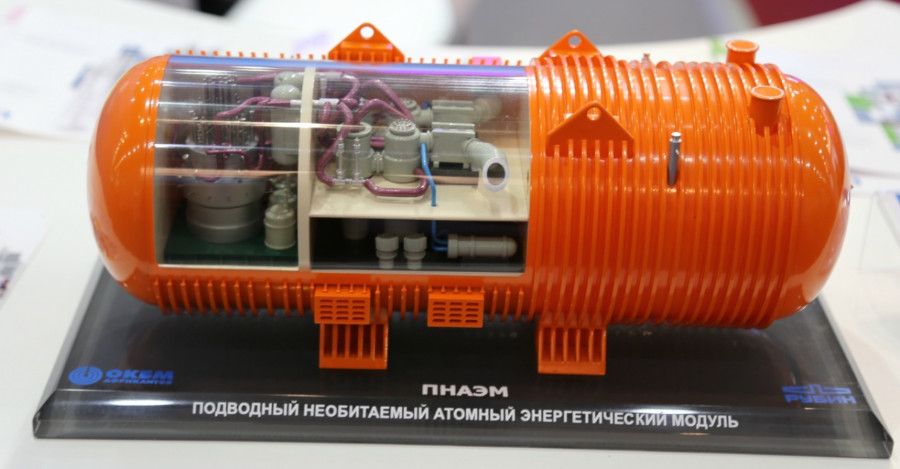
Submarine carriage of the ATGU is not required where the undersea sonar arrays are within a couple of hundred kilometers of shore. In those cases a power source on the surface can supply the sonar arrays. So the carriage by submarines indicates that the new arrays are to be placed many hundreds of kilometers from shore where there will be powered by underwater ATGUs. Additionally, if the sonar arrays are in open water then cable ships and crane ships can be used. That is the case with the SEVER system in the Barents Sea. They can be supported by GUGI's deep diving subs but the heavy lifting would be far cheaper using surface ships. Therefore the requirement to carry them on mother subs suggests that they are being laid where surface ships cannot reach, i.e. under the ice cap.
The other reason to use submarines without surface vessel support might be to maintain secrecy of the general location. This is evidently not thought necessary in the Barents Sea, and the Russian government does not appear concerned enough to hide the overall project from NATO planners. So the ice cap logic seems more compelling. However, the submarine capability does give the Russians the option to place the sensors in otherwise highly provocative locations, for example on the US-Canadian side of the Arctic.
However, the new seabed arrays would have to connect with above-surface structures to communicate with the network. This will most realistically be achieved by bringing a cable up to one of the remote islands along the ice edge. Here unmanned outstations, powered by above-ground ATGUs, would provide starlight uplinks. Some outstations could be on Siberia's remote coastline. This communication limitation makes deployment on the US-Canada side of the Arctic less likely although not necessarily impossible if very long cables were laid with ATGUs along the way.
Related: 
 Yantar spy ship loitering over undersea cables
Yantar spy ship loitering over undersea cables
Sensors
The sonar-buoy component is less clear. When deployed semi-permanently these are also prone to being tampered with by foreign navies. Despite this Russia has deployed a number of large sonar-buoy systems in the past including large passive arrays laid by ships. The most likely family is the AMGA (Амга) Autonomous Submarine Detection System which uses moored buoys which can be networked with up to 60 receivers. The system provides automatic detection, classification and tracking of low-noise submarines (it is claimed) with the information is transmitted to a coastal position on the fiber optic cable. The actual system to be used, and whether they will be powered by ATGUs is not yet known.
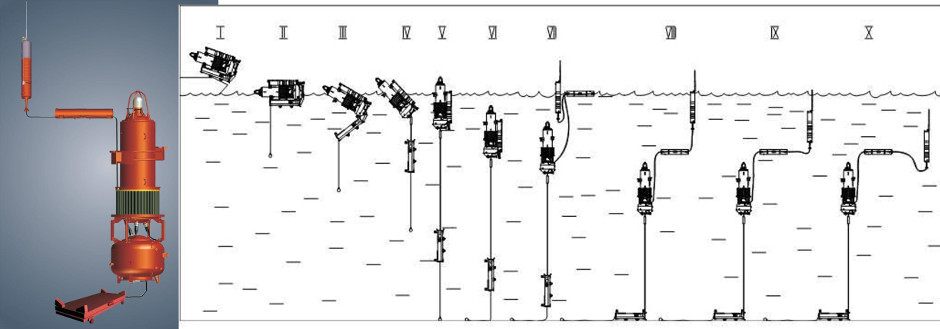
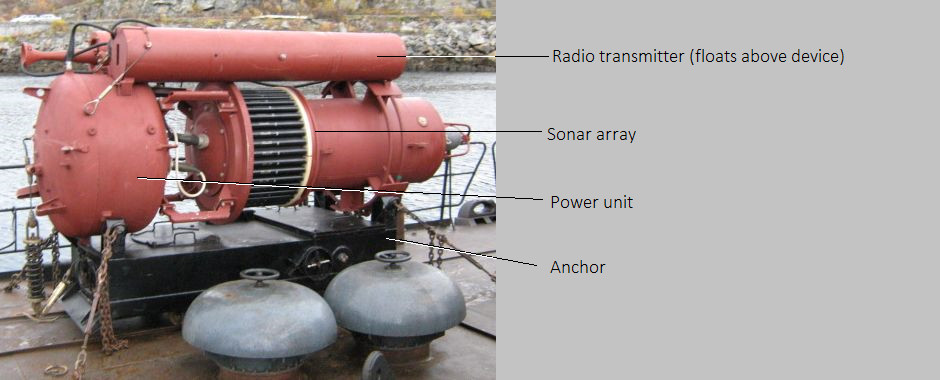
Based on the above information we can expect the new system to be several chains of sonar arrays placed on the sea floor on the Arctic Shelfs, connected by cables and powered by one or more ATGUs placed on the sea floor. These networks will be laid by the mother subs employing their deep diving midget subs. The midget subs are capable of working at depths of between 1,000m (3,000ft) for the PLATUS Class and 2,500m (7,500ft) for the Losharik. Additionally the mother subs will reply the Harpsichord family of deep diving Autonomous Underwater Vehicles (AUVs). Each network will connect to to an outstation on the surface which may be unmanned and may be on a remote arctic island or along the Siberian coast. The outstations would also use ATGU power (either submerged or on dry land) and connect to the network via satellite. The network will also employ sonar buoys in some form.
NATO submarines will not enjoy the relative invulnerability they have in the past, with the advantage possibly shifting to Russia.
Related articles (Full index of popular Covert Shores articles)

 Project 09852 Belgorod Special Mission submarine (spy sub). w/Cutaway
Project 09852 Belgorod Special Mission submarine (spy sub). w/Cutaway

 USS Jimmy Carter (SSN-23) Special Mission submarine
USS Jimmy Carter (SSN-23) Special Mission submarine

 Malachite Arctic Submarine concept
Malachite Arctic Submarine concept

 BS-64 Podmoskovye Special Mission (spy) Host Submarine
BS-64 Podmoskovye Special Mission (spy) Host Submarine

 Harpsichord AUV
Harpsichord AUV

 Project 885 'YASEN' (Severodvinsk Class) SSGN. w/Cutaway
Project 885 'YASEN' (Severodvinsk Class) SSGN. w/Cutaway

 Project 685 MIKE Class deep-diving SSN
Project 685 MIKE Class deep-diving SSN

 Project 955A 'BOREI-A' Ballistic Missile Submarine. w/Cutaway
Project 955A 'BOREI-A' Ballistic Missile Submarine. w/Cutaway

 Project 705 'ALFA' class attack submarine. w/Cutaway
Project 705 'ALFA' class attack submarine. w/Cutaway

 NR-1
NR-1

 USS Parche spy sub par-excellence. w/Cutaway
USS Parche spy sub par-excellence. w/Cutaway

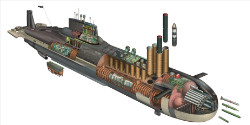 TYPHOON Class SSBN. w/Cutaway
TYPHOON Class SSBN. w/Cutaway

 Russian unbuilt spy submarine MPS
Russian unbuilt spy submarine MPS

 Russian Losharik spy sub
Russian Losharik spy sub

 Russian Seismic Survey sub
Russian Seismic Survey sub

 Project 1910 UNIFORM Class deep diving spy sub
Project 1910 UNIFORM Class deep diving spy sub

 USS Halibut. w/Cutaway
USS Halibut. w/Cutaway

 USS Seawolf (SSN-575)
USS Seawolf (SSN-575)

 Russian X-RAY Class spy sub
Russian X-RAY Class spy sub



